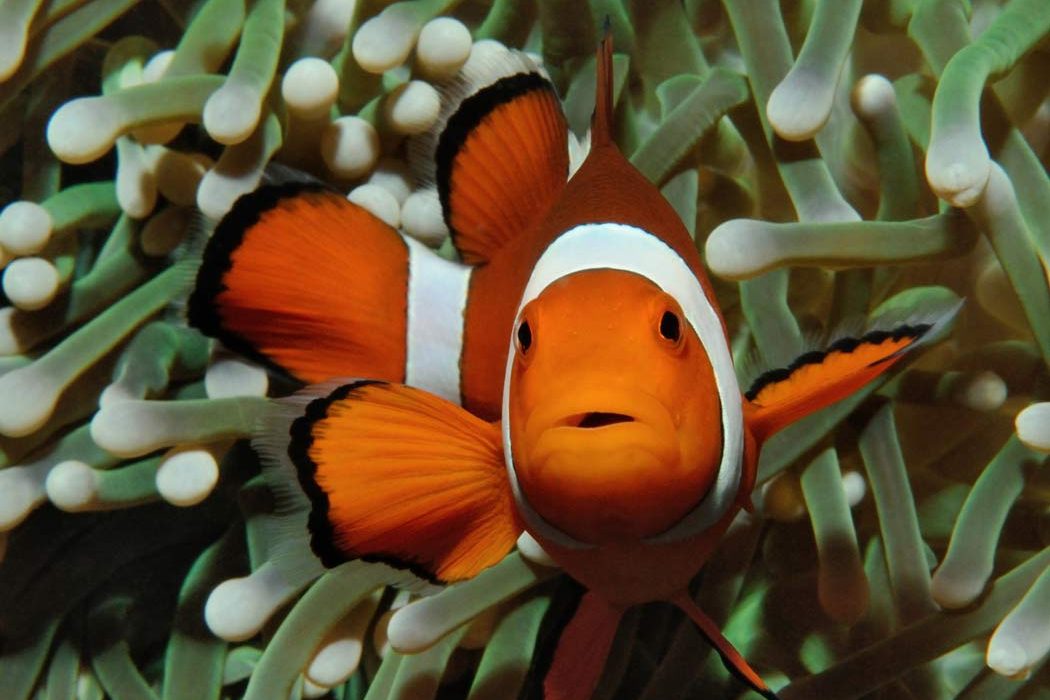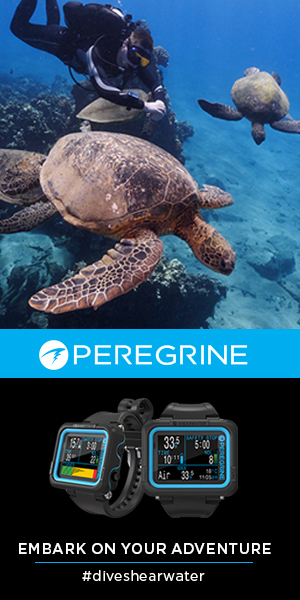If you know a kid younger than 10, then you also know the names Nemo and Dory. And just in case you’re one of the few humans on the planet who don’t know what I’m talking about, these were the “stars” in the phenomenally successful animated film, “Finding Nemo.” Nemo was the lovable, kidnapped clownfish, and Dory the memory-impaired surgeonfish. Even if your feelings toward children are more akin to those of W.C. Fields (“go’way kid, ya botha’ me”), I encourage you to see this movie. It has perhaps the best animation you’ll ever see, plus there’s also more than a little tongue-in-cheek humor that adults will appreciate.
An inevitable consequence of all popular movies is a heightened, if not frenzied, interest in the subject matter. “Finding Nemo” is no exception. So it was probably no surprise when kids wanting their own “Nemo” sent the demand for clownfish through the roof. Of course, as parents and kids soon found out, keeping Nemo was a lot more demanding task than merely finding him.
Faced with the reality of an expensive pet and a child who has lost interest, countless numbers of parents faced the dilemma that’s the crux of our story. In most areas of North America, many unwanted Nemos ended up taking their final swim in a toilet bowl. But flushing the family pet can be a tough decision to explain to a kid, so for those who live close to the ocean, the outcome could be quite different. With the options of a final swim in the porcelain aquarium, or the possibility of a new life back in the sea, many choose the one depicted in yet another movie, “Free Willy.”
One can sympathize with good intentions, and attempting to save a family pet certainly qualifies. Realistically, though, most of the freed Nemos never survive. The local waters are too cold, or the poor fish becomes a quick snack for some predator that never saw the movie and was unaware of his star status. But given the right environment, and a bit of luck, the intended consequence does occur — Nemo survives. So, end of story; everybody’s happy and no harm done, right? Not quite.
The truth is that this is neither a happy ending nor even the end of the tale. The survival of Nemo, and many of his distant cousins, in waters where they were never intended, may have grave consequences for the environment, for what was once a family pet is now an invader.
Alien Invasion!
When species become established by some human-facilitated introduction to a range where they don’t occur naturally, they are termed an invasive species, exotic or non-native species. While on the surface it may appear that this is a relatively inconsequential problem, it is all but. In a recent article published in the journal BioScience, the authors estimated that about 50,000 invasive species have been purposefully or accidentally introduced into the United States. In fact, the problem is so serious that in 1999 an international scientific journal, Biological Invasions, was launched. Some examples of invasive species are quite well-known, such as the Japanese vine kudzu which for decades has been creeping its way north from the southern region of the United States. When it comes to aquatic examples, the prodigious zebra mussel began its invasion sometime in the mid-1980s when it was introduced somewhere in the Great Lakes region from a ship’s ballast water. Today they have reached as far south as the Mississippi Delta and as far west as the Missouri River, changing the local ecology through their voracious feeding, clogging intake pipes and fouling anything in their path that stands still.
It’s no wonder that biologists refer to invasive species as “biological pollution,” as they can have a severe effect on the environment, economy and even human health. Economic damage happens when invasive species compete with or reduce commercial fish stocks, erode shorelines, clog water intake pipes or foul fishing gear, boats and buoys. And the amount of money involved is staggering. According to the BioScience article, exotic species cost the U.S. economy about $137 billion each year, and the damage isn’t all economic.
Alien species affect human health by spreading infections or toxins in wild-harvested fish and shellfish, or by providing new intermediate hosts for human parasites (such as with West Nile fever). The complete toll they take on human health is unknown, but it’s certainly significant. Alarmingly, a study published four years ago in the science journal Nature found high concentrations of viruses and bacteria — including cholera — in water and plankton samples from ballast water in ships entering Chesapeake Bay.
The effects exotic species can have on the marine environment are numerous. They can alter the availability of food, space, and spawning areas through direct competition, or they may alter the physical environment by reducing water movement, eroding shorelines, or altering the bottom. Introduction of new functional groups of organisms can cause detrimental changes in the food web, or cause harmful algal blooms. Even future generations of organisms are at risk because exotic species can alter gene pools through hybridization. Sometimes, entire populations can be displaced in favor of the invaders. The long-term consequences of this alien invasion aren’t well understood, but aren’t likely to be good. What the final price tag is on compromised biological communities only future generations can tell us.
A general overview of how alien species affect major regions of U.S. waters was published last year by the Pew Oceans Commission (see sidebar). Here are just a few of the highlights: San Francisco Bay now has more than 230 alien species, and they are growing at a rate of one new introduction every two weeks. The bay has been so fundamentally changed by alien species that many ecologists no longer consider it a “natural” ecosystem. While this invasion took many years, others have not. Since 2001 alone other major invasions have occurred or have become rampant. For example, vast populations of the Pacific spotted jellyfish (Phyllorhiza punctata) have invaded the Gulf of Mexico, along with the brown mussel (Perna perna). The Gulf of Maine now sees billions of small carnivorous European flatworms (Convoluta convoluta) blossom each summer. The Asian whelk (Rapana venosa) has arrived and continues to grow in the Chesapeake Bay. This shellfish predator could spell the end for the bay’s long-suffering oyster industry — once the largest in the world. The Japanese mahogany clam (Nuttallia obscurata) has reached southern Oregon, and the Asian shore crab (Hemigrapsu sanguineus) has reached astronomical numbers in Long Island Sound. Asian kelp (Undaria pinnatifida) was discovered in Southern California, and in the Pacific Northwest tens of thousands of farmed Atlantic salmon (Salmo salar) escape into the wild to cross-breed with native species. And these are only some of the more well-documented events.
Another invader that’s received quite a bit of attention is the green seaweed Caulerpa taxifolia. Known as the “killer algae,” Caulerpa was introduced into the Mediterranean from an aquarium, and has wrought environmental destruction to large portions of the region’s coastal ecosystems. Today, acres of algal mat cover habitat that was once rich marine communities. It’s now well established in California, and a different species (Caulerpa vertisilada) is covering vast tracks of coral reef in Florida’s Palm Beach County.
Another frightening consequence of biological invasions is what scientists term the “homogenization” of ecosystems. The Black Sea is one tragic example of not only environmental damage but economic collapse. The unremarkable comb jelly (Mnemiopsis leidy) was introduced there in the early 1980s by ballast water from a visiting ship. Incredibly, it now comprises up to 95 percent of the biomass in the Black Sea. It feeds on zooplankton, eggs and fish larvae, and has devastated the anchovy fishery, which was once worth more than $250 million a year. Just how serious is this problem worldwide? Some biologists believe that invasive species may be second only to habitat loss as a leading cause of extinction.
How Invasive Species Got Here
A primary mechanism for biological invasions is the ballast water needed to stabilize ships for transit at sea. While this may not seem like a major factor, consider this: According to the United Nation’s International Maritime Organization (IMO), some 10 billion metric tons of water are moved around the world each year, with about 79 million metric tons discharged yearly into U.S. waters. In a recent study, it was shown that 367 different plants and animals were found in the ballasts of 159 ships arriving in Oregon from Japan. It has been estimated that, on any one day, some 3,000 species are in motion around the world in ballast water.
Still, hitching a ride in the bilge of a ship isn’t the only way invaders arrive. Other sources of marine introduction and distribution include the import of live bait; canals and connecting waterways such as those in Suez and Panama; biological control programs where non-native species are deliberately released to control pests; releases and escapes from laboratories and aquaria (as was the case with the killer algae, Caulerpa) and through escape from aquaculture facilities. The Pew Oceans Commission report even cites distribution of invasive species by aquatic recreational equipment such as scuba gear. (Remember that the next time you put off rinsing your equipment.)
From Ships to People
One pathway invasive species may take that’s received little attention was illustrated in the story of Nemo’s journey — through home aquariums. Some scientific studies have looked at the consequence of invasions by freshwater aquarium fish. This is a significant problem throughout the Florida Everglades. In fact, it’s almost impossible to find a puddle of water in the famous River of Grass that doesn’t contain an alien fish species; and it’s not uncommon in many cases for the aliens to outnumber the natives. Yet, the role saltwater aquarium enthusiasts play has, until recently, received very little attention.
Years ago, the sighting of an Indo-Pacific lionfish off of Palm Beach County, Florida, by a staff member at Pura Vida Divers got widespread local and even some national attention. Currently, both Florida’s Department of Environmental Protection and the National Oceanic and Atmospheric Administration (NOAA) are asking divers to report additional sightings. (See the latest on the invasive species here) But to savvy Florida divers, these sightings are anything but novel or limited to the glamorous lionfish. Other widely distributed invasive species reported are the sailfin tang and emperor angelfish.
University of Washington researcher Brice Semmens and his colleagues published an important study in the journal Marine Ecology Progress Series entitled, “A Hotspot for Non-Invasive Fishes: Evidence for the Aquarium Trade as an Invasion Pathway.” The results probably weren’t startling to anyone familiar with Florida’s reefs, but they brought the nature and magnitude of the problem into focus. The report demonstrated for the first time that the alien fishes probably reach Florida’s reefs not through ballast water, but through aquarium enthusiasts releasing their pets into the wild. Our story about Nemo is probably dead-on. What’s more, the trend started long before the movie was even conceived.
The problem was first identified in Florida by the fish survey project maintained by the Reef Environmental Education Foundation (REEF). The organization has monitored fish populations in many areas of the world for well over a decade, but nowhere longer than in Florida. REEF volunteers began sighting species that weren’t Florida nor Caribbean natives in 1994 when a pair of Indo-Pacific batfish took up residence on Molasses Reef. To date, at least 16 species of Indo-Pacific reef fishes have been seen. At the time Semmens’ paper was published, there were 40 reported sightings, with 32 of those documented by multiple independent sources or photographic evidence (see Tables 1 and 2 for details). REEF has reports of even more species sightings since then.
The Key is Education
As with most environmental problems, the solution begins with education. Of course, some people still blithely throw trash out their car window so, for some, the consequence of releasing some organism into the wild where it doesn’t belong will get little or no consideration. These are people for whom nothing will ever change their attitudes or behaviors. However, divers and serious aquarists are usually more concerned with the marine environment than the average Joe. That’s where the educational effort has to start. Recently there’s been a novel approach that both addresses the problem directly and provides an ongoing educational opportunity. It involves a collaborative effort among the Florida Keys National Marine Sanctuary, Dynasty Marine Inc., REEF and the New England Aquarium. The team collected two of three batfish that have called Molasses Reef in Key Largo home for nearly a decade. While two were caught, the third escaped, but has since been sighted. The captives now reside at the aquarium’s home in Boston Harbor, where senior aquarist Holly Martel Bourbon calls them “poster fish for the dangers posed by invasive species.”
Semmens and his colleagues agree that education is the key to overcoming the alien invasion. But, he says, “The problem is that there isn’t any mechanism currently in place to educate aquarium enthusiasts about the potential pitfalls of releasing pets into the wild.” Indeed, it is technically against the law to release non-native marine species into coastal waters, but enforcing the law is virtually impossible. People can’t simply be told not to do it, but also must be informed why they shouldn’t. Additionally, the aquarium industry, as well as the diving community, needs educational programs and mechanisms to distribute information that clearly explains the problems and encourages alternatives. One such alternative could be selling back or trading in unwanted fish.
Some may wonder what all the fuss is about over adding more fish to the reefs of South Florida. After all, isn’t that why divers go there? Semmens answers that question in two ways. From a scientific perspective, he compares releasing non-native reef fish to playing “environmental Russian roulette.” The consequences are completely unknown, and ample evidence exists that what often happens isn’t for the good.
But there’s an aesthetic issue that we must also consider. “Divers visit the reefs of Florida to see the region’s natural beauty and diversity,” says Semmens. “It’s a unique and magical experience to dive on these reefs, and adding new species to the region is comparable to adding a few finishing touches to one of da Vinci’s masterpieces. It doesn’t matter if you believe in divine creation, or the balance of nature resulting from the struggle for existence: Either way we are messing around with a work of art.” It appears that finding Nemo was only the first part of the saga. His appearance on your local reef could be the sequel we don’t want to see.
Table 1
Non-native fish species documented by REEF volunteers and the number of locations where they’ve been sighted (Source for tables 1 and 2: “A Hotspot for Non-Invasive fishes: Evidence for the Aquarium Trade as an Invasion Pathway,” by B.X. Semmens, E.R. Buhle, A.K. Salomon, and C.V. Pattengill-Semmens, published. January 30, 2004)
Common Name Scientific Name Locations
Lionfish Pterois volitans 5
Panther grouper Chromilepets altivelis 1
Raccoon butterflyfish Chaetodon lunula 1
Orbicular batfish Platax orbicularis 3
Blue ringed angelfish Pomacanthus annularis 1
Arabian angelfish Pomacanthus asfur 2
Emperor angelfish Pomacanthus imperator 6
Yellowbar angelfish Pomacanthus maculosus 3
Semicircle angelfish Pomacanthus semicirculatus 3
Moorish idol Zanclus cornutus 1
Orangespine unicornfish Naso lituratus 1
Sohal surgeonfish Acanthurus sohal 1
Sailfin tang* Zebrasoma desjardini 7
Yellow tang Zebrasoma flavescens 3
Yellowtail sailfin tang Zebrasoma xanthurum 2
* It is unknown whether one of these sightings is the species desjardini or veliferum.
Resources
For further information on invasive species, see the following resources:
“Introduced Species in U.S. Coastal Waters:
Environmental Impacts and Management Priorities” by J.T. Carlton, 2001;
available at www.pewoceans.org/reports/introduced_species.pdf
“Environmental and economic costs of nonindigenous species in the United States,”
by D. Pimentel et al., 2000, published in BioScience 50(1): pages 53-64.
“Global spread of microorganisms by ships,” by G.M. Ruiz et al., 2000,
published in Nature 408, pages 49-50.






